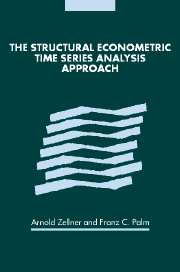Book contents
- Frontmatter
- Contents
- List of contributors
- Acknowledgments
- Introduction
- Part I The SEMTSA approach
- Part II Selected applications
- Part III Macroeconomic forecasting and modeling
- 13 Macroeconomic forecasting using pooled international data (1987)
- 14 Forecasting international growth rates using Bayesian shrinkage and other procedures (1989)
- 15 Turning points in economic time series, loss structures, and Bayesian forecasting (1990)
- 16 Forecasting turning points in international output growth rates using Bayesian exponentially weighted autoregression, time-varying parameter, and pooling techniques (1991)
- 17 Bayesian and non-Bayesian methods for combining models and forecasts with applications to forecasting international growth rates (1993)
- 18 Pooling in dynamic panel data models: an application to forecasting GDP growth rates (2000)
- 19 Forecasting turning points in countries' output growth rates: a response to Milton Friedman (1999)
- Part IV Disaggregation, forecasting, and modeling
- Subject index
- Author index
- References
17 - Bayesian and non-Bayesian methods for combining models and forecasts with applications to forecasting international growth rates (1993)
Published online by Cambridge University Press: 24 October 2009
- Frontmatter
- Contents
- List of contributors
- Acknowledgments
- Introduction
- Part I The SEMTSA approach
- Part II Selected applications
- Part III Macroeconomic forecasting and modeling
- 13 Macroeconomic forecasting using pooled international data (1987)
- 14 Forecasting international growth rates using Bayesian shrinkage and other procedures (1989)
- 15 Turning points in economic time series, loss structures, and Bayesian forecasting (1990)
- 16 Forecasting turning points in international output growth rates using Bayesian exponentially weighted autoregression, time-varying parameter, and pooling techniques (1991)
- 17 Bayesian and non-Bayesian methods for combining models and forecasts with applications to forecasting international growth rates (1993)
- 18 Pooling in dynamic panel data models: an application to forecasting GDP growth rates (2000)
- 19 Forecasting turning points in countries' output growth rates: a response to Milton Friedman (1999)
- Part IV Disaggregation, forecasting, and modeling
- Subject index
- Author index
- References
Summary
Introduction
In past work, Garcia-Ferrer et al. (1987) and Zellner and Hong (1989), variants of a relatively simple autoregressive model of order three containing lagged leading indicator variables, called an ARLI model, provided good one-year-ahead forecasts of annual output growth rates for eighteen industrial countries, 1974–84. In Zellner, Hong, and Gulati (1990) and Zellner, Hong, and Min (1991), this ARLI model and variants of it produced good turning point forecasts, about 70–80 percent of 158 turning points correctly forecasted. In Hong (1989), the ARLI model's cyclical properties were analyzed and its forecasting performance was shown to be slightly superior to that of a version of Barro's “money surprise” model. LeSage (1989) and LeSage and Magura (1990) have used ARLI models to forecast employment growth rates and turning points in them for eight metropolitan labor markets with satisfactory results. Blattberg and George (1991) used similar techniques in successfully forecasting sales of different brands of a product.
Some of our past work has involved use of fixed parameter models (FPMs) and time-varying parameter models (TVPMs). In the present chapter, we derive and compute posterior odds relating to our FPMs and TVPMs using data for eighteen countries, 1973–87. While there are many reasons – Lucas effects, aggregation effects, wars, etc. – for believing that parameters may be time-varying, economic theorists' models are generally fixed parameter models. Our calculated posterior odds will shed some light on the parameter constancy issue and are used to choose between FPMs' and TVPMs' forecasts year by year.
- Type
- Chapter
- Information
- The Structural Econometric Time Series Analysis Approach , pp. 559 - 589Publisher: Cambridge University PressPrint publication year: 2004
References
- 2
- Cited by



